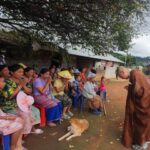Written by Anchalee Kurutach
In July 2025, northern provinces of Thailand and the Lao People’s Democratic Republic experienced the most severe flooding in over four decades, caused by persistent heavy rainfall and the impact of Tropical Storm Wipha.
During the recent INEB–Jungto monastic study trip in late June 2025, two participants were venerable monks from flood-affected areas—one from Nan Province in Thailand and another from Vientiane, Lao PDR. Upon learning about the flooding, Ven. Pomnyun Sunim promptly reached out to INEB and asked us to coordinate emergency relief through Join Together Society (JTS). JTS swiftly provided funds to support the two monks in their community relief work.
LAO PEOPLE’S DEMOCRATIC REPUBLIC
In Lao PDR, Luang Prabang Province was among the most severely affected areas. Continuous rainfall and discharges from upstream hydropower dams caused the Khan River to overflow, flooding nearby communities—including areas around the Khan Riverside and Phousi Hill. Homes, farmland, and roads were inundated, leading to power outages, travel disruptions, and widespread displacement. Authorities mobilized emergency personnel to help residents relocate belongings and livestock to safer ground, conducted damage assessments, and supported coordinated relief responses.
Ven. Sayadej Vongsopha traveled from Vientiane to Luang Prabang and worked closely with local leaders in Nan District (not to be confused with Thailand’s Nan Province), one of the hardest-hit areas. Ten villages in the district—comprising 916 families (4,773 people, including 2,351 women)—were significantly impacted. With funding from JTS, Ven. Sayadej focused on delivering emergency relief packages, including food and essential supplies, to 350 of the most vulnerable families. He carried out this effort in collaboration with the Red Cross and local authorities, ensuring timely and equitable distribution of aid.
Photos from Lao PDR (Credit: Ven. Sayadej)
THAILAND
In Thailand’s Nan Province, the Nan River overflowed across several districts, including Muang, Thawangpha, and Phu Phiang, inundating homes, infrastructure, and key cultural landmarks. The floodwaters, nearing record levels, disrupted local markets, hospitals, and transportation networks. Emergency response teams were mobilized, temporary shelters set up, and water management efforts enacted—including dam discharge reductions—to minimize downstream damage. Despite these efforts, widespread flooding continued along the Nan River basin, drawing comparisons to the catastrophic floods of 1981 and prompting extended recovery operations into late July.
Ven. Khongsin Khuean-on of Thawangpha District, Nan Province, was directly impacted—trapped on the second floor of his temple for days while the flood completely submerged the first floor. He described it as the worst flooding he has experienced in his lifetime. Sixty novices at the monastic school under his care were left without a safe place to sleep. Despite these challenges, monastic and lay communities came together to support one another in clean-up and recovery efforts. Many essential household and educational items were damaged or lost.
With JTS funding, Ven. Khongsin established a Disaster Relief Center to serve the community. The center immediately purchased high-pressure water pumps and other cleaning equipment to clear thick mud and debris. Plans are underway to acquire additional tools such as boats, life jackets, rice cookers, freezers, emergency medical kits, and food storage units. Additionally, three wells will be dug to ensure access to clean water for post-flood recovery and future preparedness. In addition, the relief team has identified 300 families who were severely affected and will be delivering each family a rice cooker, the most essential household item urgently needed.
Photos from Thailand (Credit: Ven. Khongsin)
Thanks to the timely and compassionate response of Ven. Pomnyun Sunim, both venerables were able to provide critical, immediate assistance to their communities. INEB remains deeply grateful to have played a role in facilitating this support. We recognize that such extreme weather events are becoming more frequent due to climate change and are committed to working with our kalyanamitta to seek sustainable alternatives for living in harmony with nature.
For more information about our Eco-Temple initiatives or other INEB programs, please visit www.inebnetwork.org.











